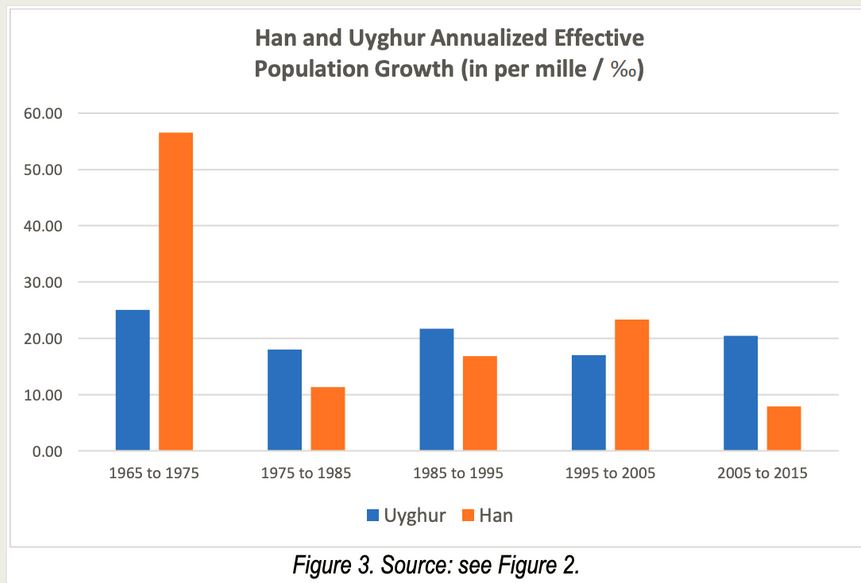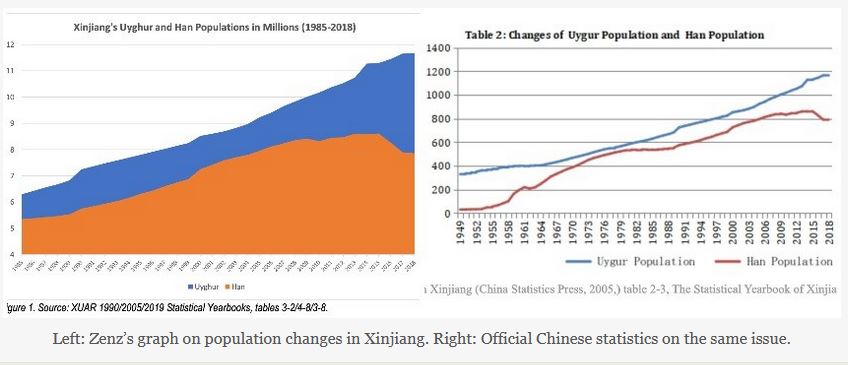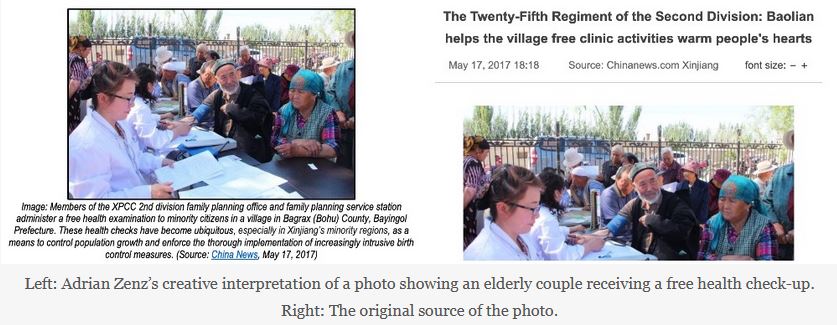By Gareth Porter and Max Blumenthal
The Trump and Biden
administrations have relied on the work
of a right-wing religious extremist,
Adrian Zenz, for their “genocide”
accusation against China. A close review
of Zenz’s research reveals flagrant data
abuse and outright falsehoods.
February 23, 2021 "Information
Clearing House" - - "Grey
Zone" - Both
President Joe Biden and his Secretary of State
Anthony Blinken have endorsed former Secretary of
State Mike Pompeo’s last-minute accusation of “genocide”
against the Muslim Uyghur population in China’s
Xinjiang province.
But an investigation of
published work by the researcher Pompeo relied on to
level his genocide allegation reveals a pattern of
data abuse and fraudulent assertions that
substantially undermines the incendiary charge.
The U.S. government’s
accusation of genocide against China stems from a
single source: a June 2020 paper
by Adrian Zenz,
a right-wing German researcher affiliated with the
Victims of Communism Memorial Foundation and
neoconservative Jamestown Foundation in Washington,
D.C.
Articles by the
Associated Press, CNN, and BBC also relied on Zenz’s
article to claim that plunging Uyghur birth rates
and the application of birth control measures in
Uyghur counties of the Xinjiang region were proof of
a policy of “demographic genocide.”
Just days after the
publication of Zenz’s paper, Pompeo issued
a statement denouncing China’s alleged policy of
“forced sterilization, forced abortion, and coercive
family planning,” personally crediting “Adrian
Zenz’s shocking revelations.”
Biden backed the the
genocide charge last August when it first appeared
in a flurry of media reports. His campaign
spokesman told
Politico,
“The unspeakable oppression that Uyghurs and other
ethnic minorities have suffered at the hands of
China’s authoritarian government is genocide and Joe
Biden stands against it in the strongest terms.” Blinken,
for his part, declared at his first press conference
as secretary of state that he agreed genocide has
been committed against the Uyghurs.
While Zenz’s employers
describe him as “one of the world’s leading scholars
on People’s Republic of China government policies
towards the country’s western regions of Tibet and
Xinjiang,” he is, in fact, a far-right
Christian fundamentalist who has said he is “led by
God” against China’s government,
deplores homosexuality and gender equality, and has
taught exclusively in evangelical theological
institutions.
No Advertising - No Government
Grants - This Is Independent Media
Lyle Goldstein, a China
specialist and research professor in the Strategic
and Operational Research Department of the Naval War
College, told The Grayzone that Zenz’s
labeling of the Chinese approach to the Uyghurs as
“demographic genocide” is “ridiculous to the point
of being insulting to those who lost relatives in
the Holocaust.”
Goldstein said the
Chinese approach to Xinjiang “is a more repressive
posture than we would like, but it sure isn’t
genocide.”
Moreover, a careful
review of Zenz’s research shows that his assertion
of genocide is contradicted by flagrant data abuse,
fraudulent claims, cherry-picking of source
material, and propagandistic misrepresentations.
Genocide or Family
Planning Policy?
In Adrian Zenz’s 2020
paper for the Jamestown Foundation, he boasted that
his findings “provide the strongest evidence yet
that Beijing’s policies in Xinjiang meet one of the
genocide criteria cited in the U.N. Convention on
the Prevention and Punishment of the Crime of
Genocide.”
Zenz was referring
Article 2 (d) of that Convention: “Imposing measures
intended to prevent births within the group.” But
Article II qualifies the relevant acts as those
“committed with intent to destroy, in whole or in
part, a national, ethnical, racial or religious
group, as such.”
But “preventing births”
by itself cannot be evidence of alleged genocide
without evidence of intent to destroy the group in
question. Otherwise, any birth
control program provided to an ethnic group
would be prima facie evidence of a policy of
genocide against the group.
Zenz argued that
population control measures applied to Uyghurs could
be branded as “genocidal” because population growth
rates fell by 84 percent in the two largest Uyghur
prefectures between 2015 and 2018, and declined
further in several minority regions in 2019. But
more complete statistics that Zenz cited in his
report, and data that he conveniently omitted,
contradicted his conclusion.
Zenz provided
statistics revealing that between 2005 and 2015,
Uyghur population growth in Xinjiang was 2.6 times
higher than that of Han Chinese in the Xinjiang
region. (The chart displayed in his report is
below).

Both official
Chinese figures and
Zenz agree that the Uyghur population in Xinjiang
increased significantly between 2010 and 2018.

Left: Zenz’s graph on population changes in
Xinjiang. Right: Official Chinese statistics on
the same issue.
Zenz’s figures shows an
increase in Uyghur population from 10.1 million to
11.8 million during the 2010 and 2018, while Chinese
government figures demonstrate an even larger
increase from 10.1 to 12.7 million. That means the
Uyghur population in Xinjiang grew by a staggering
25.04 percent.
Zenz shows the Han
Chinese population rising from 8.5 to 9.8 million
during the eight-year period, while Chinese
government figures show a smaller increase in Han
population from 8.8 million to 9 million.
Both the rapid surge in
Uyghur population growth rates and the increased
margin of the Uyghur majority over the Han
population of Xinjiang in recent years are the
result of the one-child policy imposed on Han
Chinese couples by the Chinese government in 1979.
According to China
specialist Martin King Whyte, the one-child policy
was accompanied by a long-term pattern
of abuses in
its implementation, including “intrusive menstrual
monitoring, coerced sterilizations and abortions,
staggering monetary fines for ‘over-quota’ births,
smashing of furniture and housing of those who
resist and withholding registration for babies born
outside the plan.”
Uyghur families,
however, were exempted from the one child policy.
Urban Uyghur couples were allowed to have two
children, and rural Uyghur couples three. In
practice, moreover, rural Uyghurs often had large
families, with as many as nine or ten children in
some cases, as even Zenz acknowledged.
In 2015, the Chinese
government announced
a relaxation of
the decades-long one-child limit on urban Han
couples, allowing urban couples to have two children
and rural families to have three. In Xinjiang, where
birthrates routinely exceeded previously
established limits, local officials urged the equal
application of family planning policy between Han
and Uyghur couples.
In July 2017,
Xinjiang’s regional government ended
the exemption on the old child limits for Uyghurs.
Uyghur couples were thus expected to follow the same
limitations recently imposed on Han couples: two
children in urban areas and three in rural regions.
As the Chinese
government has freely
acknowledged,
a 5 percent decrease in the birth rate in Xinjiang
between 2017 and 2018 was the result of the equal
enforcement of family planning policy across ethnic
lines.
While eliding this
point, Zenz also overlooked the fact that China’s overall
birthrate has fallen precipitously
in recent years across the demographic spectrum as
the population ages and contraceptives become more
widely available through programs like the government’s
annual free distribution of one billion condoms.
For example, in the city of Guangzhou, which is far
from Xinjiang, the rate of newborn babies has plunged
to its lowest point in a decade.
Cherry Picking &
Distortion
Also in 2017, China’s
National Health and Family Planning Commission
announced a $5.2 billion healthcare investment in
Xinjiang, stating its intention to strengthen a
brittle health infrastructure in impoverished, rural
areas of the region.
According to Chinese
government statistics, maternal and infant mortality
rates in Xinjiang were nearly
halved by 2018,
while average life expectancy rose as a result of
increased public health investments. A 2019 study
by Lancet described
China’s improvement of maternal health and infant
mortality reduction as a “remarkable success story.”
Another study that year by the Chinese
Academy of Medical Sciences arrived
at a similar conclusion. How these positive health
indicators could serve as proof of genocide was left
unexplained by Zenz, who simply omitted the numbers
from his report.
Throughout his paper,
Zenz framed the expansion of public healthcare
services in Xinjiang as evidence of a genocide in
the making. For example, Zenz pointed to a
photograph of Uyghur residents of rural regions of
Xinjiang receiving medical consultation at a free
health clinic as part of an “effort to enforce the
thorough implementation of increasing intrusive
birth control efforts.”
However, the photograph
depicted an elderly couple who were far too old to
have children, and was dated May 2017 – months
before the Chinese government announced an end to
the child limit exemption for Uyghurs.

Left: Adrian
Zenz’s creative interpretation of a photo
showing an elderly couple receiving a free
health check-up. Right: The original source of
the photo.
According to the
original source of the photograph, an
article in China News,
it depicted a regiment from the Xinjiang Production
and Construction Corps deploying to a rural province
as part of the government’s poverty eradication
program. There, the doctors “measured blood
pressure, electrocardiogram, blood sugar, height and
weight for poor villagers who came to see the doctor
for free… More than 200 poor people were diagnosed
and treated, and more than 100 common drugs were
distributed on the spot.”
At another point in his
paper, Zenz cited an August
2019 document from
Xinjiang’s Wenquan County government office as
evidence of “greater pressure to implement intrusive
birth control methods.” He referred to a single
mention of 468 “birth control surgeries,” which
could alternately be translated as “family planning
operations,” but provided no evidence that the
operations were coercive. Revealingly, Zenz omitted
the next line, which expressed satisfaction with a
birth rate of 8.11 percent.
Zenz proceeded to
ignore the rest of the document, which touted the
increased provision of free mental health services,
polio vaccinations and AIDS prevention treatment as
well as poverty alleviation measures and the
construction of new hospitals and medical clinics
for the population of Xinjiang.
How did a massive
investment to improve the health of previously
neglected rural communities fit within the framework
of a policy of genocide? Once again, Zenz avoided
the issue entirely.
Inventing Statistics &
Spinning Tales
Among Zenz’s “major
findings” was the claim that “80 percent of all net
added IUD placements in China… were performed in
Xinjiang, despite the fact that the region only
makes up 1.8 percent of the nation’s population.”

According
to the 2019 China Health Statistics Yearbook
published by the National
Health Commission –
the original source of Zenz’s claim – the number of
new IUD insertion procedures in Xinjiang in 2018
accounted for only 8.7 percent of China’s total. So
Zenz’s “major finding” was off by a factor of 10, a
staggering error that undermined the entire
substance of his argument.
Zenz also omitted
mention of the 89,018 IUDs that were removed in
Xinjiang in 2018, perhaps because those numbers
further undercut his claims of genocide.
The Chinese government
has published the
statistical yearbook chart that Zenz relied on to
concoct his “major finding.” The relevant sections
were translated by a native Chinese speaker and are
displayed below. A full translation of the chart can
be viewed here.